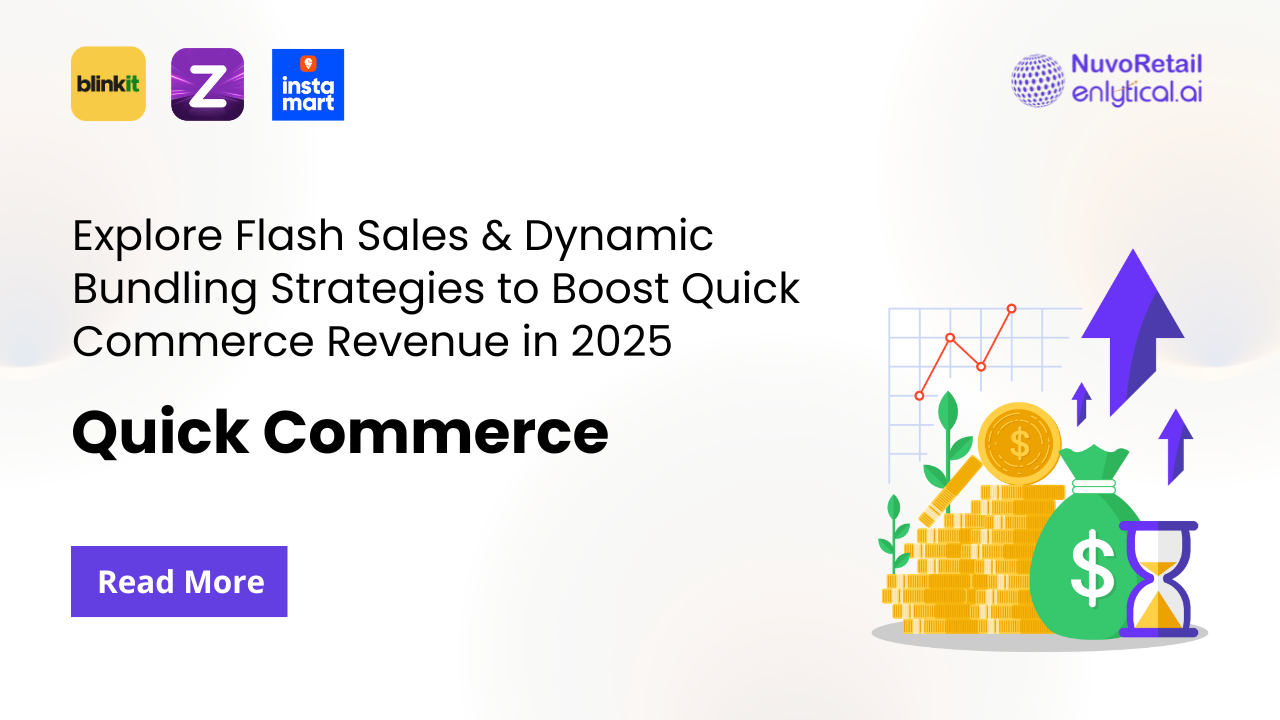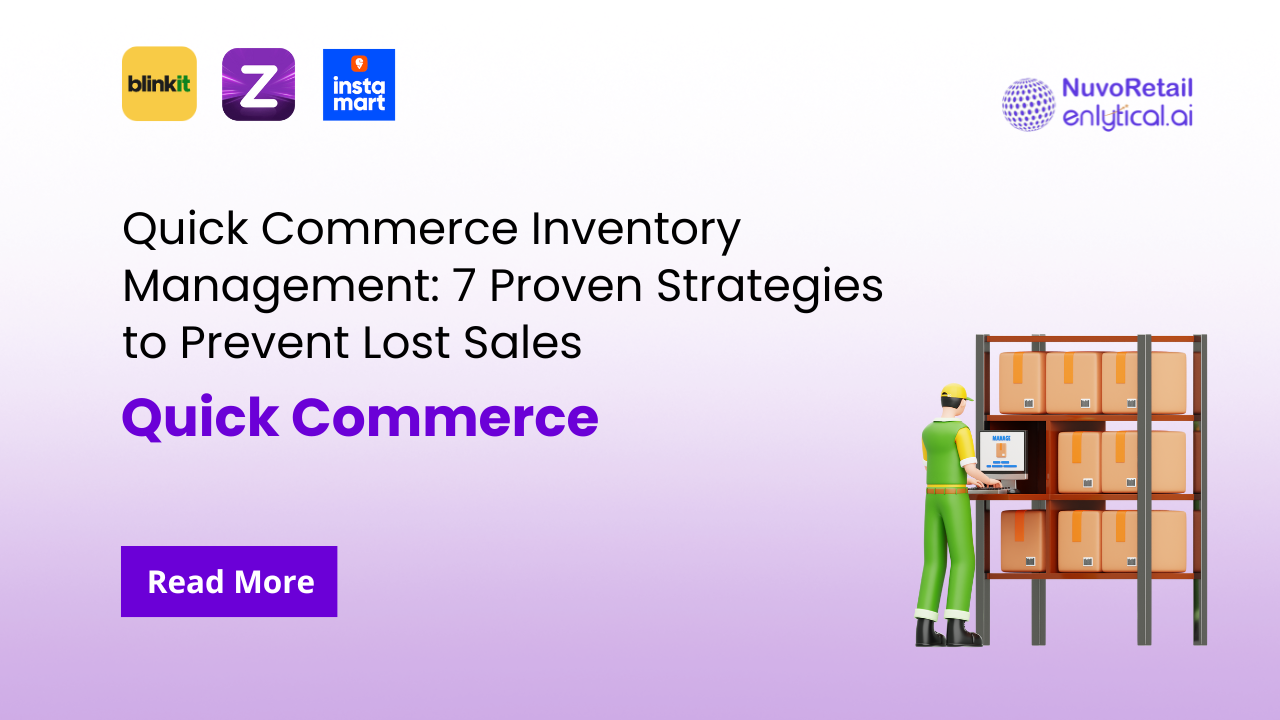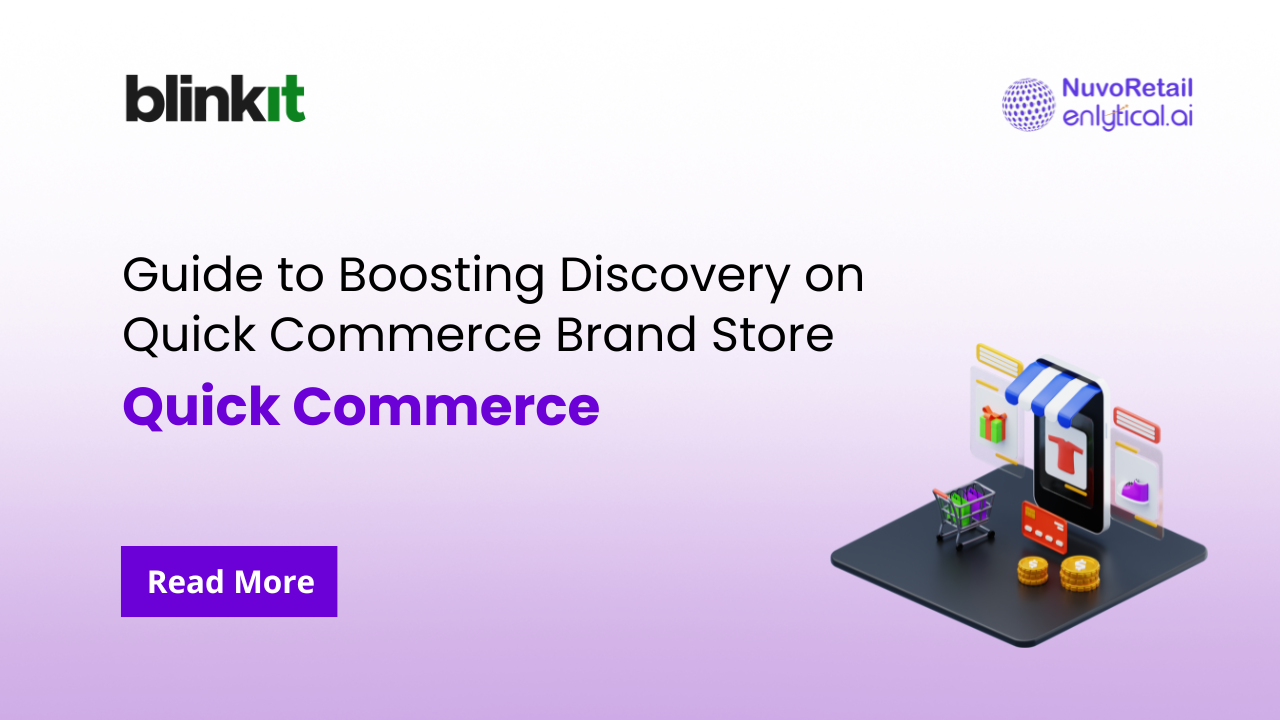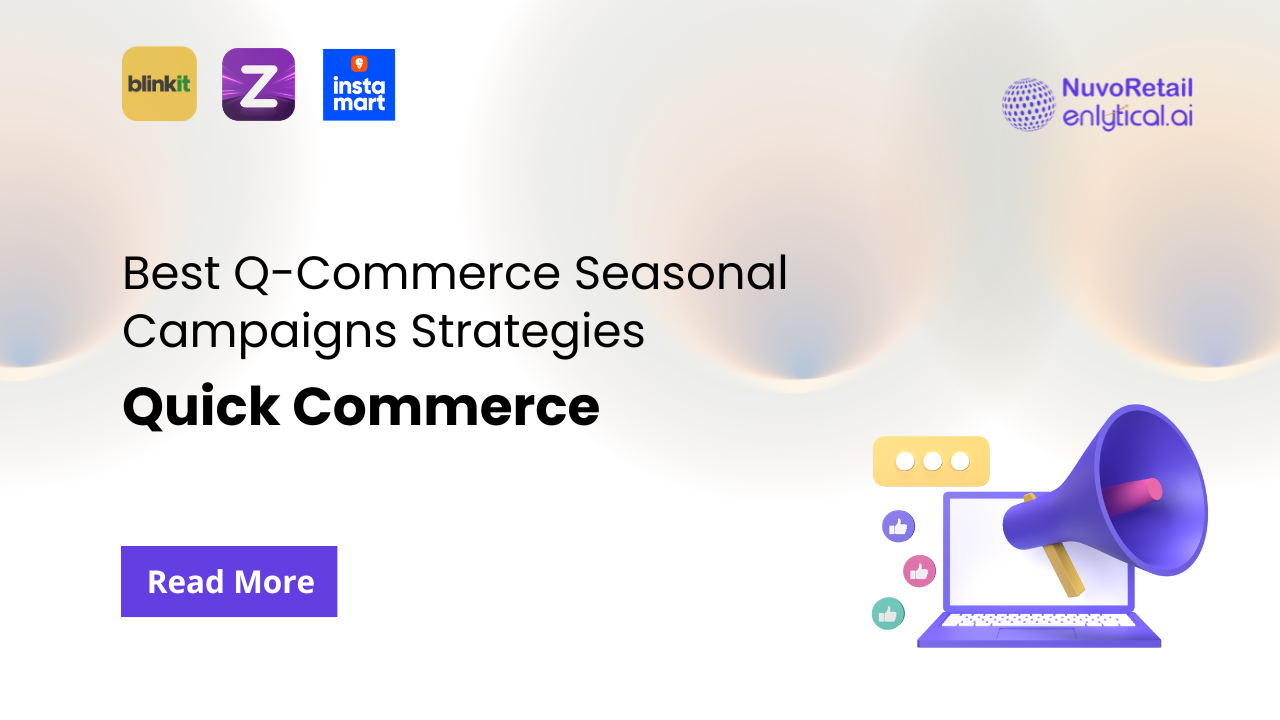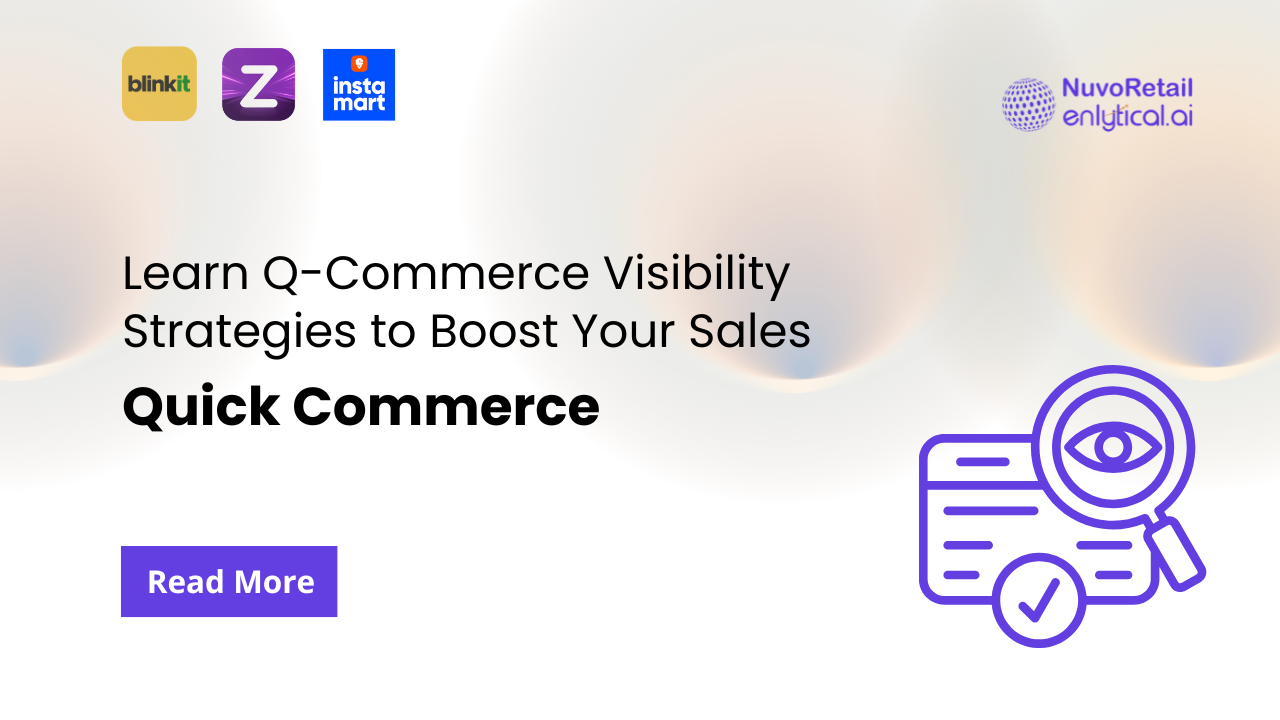Quick commerce revenue optimization has become critical for rapid delivery platforms competing in India’s explosive on-demand market. With platforms like Blinkit, Zepto, and Swiggy Instamart battling for market share, strategic approaches like flash sales and dynamic bundling are proving effective for driving growth. These tactics don’t just boost immediate sales—they help transform customer purchasing patterns and improve platform profitability.
The quick commerce sector has evolved from basic convenience delivery to sophisticated revenue optimization, where timing and customer psychology play crucial roles in business success. This is where performance-driven partners like NuvoRetail add value helping quick commerce brands maximize quick commerce revenue through hyperlocal campaigns, conversion-focused flash sales, and data-driven bundling. Our quick commerce marketing services are built around real-time insights, ensuring platforms don’t just compete on speed but also on profitability and sustainable growth.

Table of Contents
- Understanding Quick Commerce Revenue Models
- Flash Sales Strategy for Quick Commerce
- Dynamic Bundling Implementation
- Platform-Specific Approaches
- Implementation Best Practices
- Success Metrics and KPIs
- Advanced Revenue Optimization Techniques
Understanding Quick Commerce Revenue Models
Quick commerce revenue models differ significantly from traditional e-commerce due to the ultra-fast delivery expectations that define this segment. Unlike conventional platforms, where delivery can span hours or days, quick commerce promises fulfillment within 10 to 30 minutes, which places a premium on speed, efficiency, and precision. The success of these platforms hinges on three critical factors: order frequency, average order value (AOV), and operational efficiency. Each of these elements directly impacts quick commerce revenue, making it essential for businesses to monitor, optimize, and align them with consumer behavior.
At the same time, quick commerce companies face unique profitability challenges, including high delivery costs, inventory management complexities, and real-time demand fluctuations. However, these challenges also open up targeted opportunities for revenue optimization such as flash sales, dynamic bundling, and personalized promotions designed to increase order volume, maximize AOV, and enhance customer loyalty. Understanding and strategically managing these revenue levers is key to sustaining growth in this fast-paced, high-demand market.
Current Market Dynamics
The Indian quick commerce market has experienced significant growth, with platforms like the Blinkit app and Zepto online expanding rapidly. Swiggy Instamart operates in over 40 cities, while Zepto’s growth strategy has established strong market presence.
Rapid delivery services are finding that traditional e-commerce tactics require adaptation for the q commerce model. Flash sales and dynamic bundling work particularly well because they align with the impulse-driven nature of quick commerce purchases.
The digital shelf experience in quick commerce emphasizes speed and convenience, making targeted promotions highly effective when properly timed.
Flash Sales Strategy for Quick Commerce
Flash sales in the quick commerce space operate on highly compressed timelines designed to meet the speed and convenience expectations of today’s consumers. Unlike traditional e-commerce flash sales that may last 24 to 48 hours, quick commerce platforms typically run promotions within much shorter windows—often just 2 to 6 hours. These rapid, time-sensitive offers create a sense of urgency, encouraging customers to make immediate purchases and helping platforms maximize order volume in a limited timeframe. When implemented effectively, flash sales can become a powerful lever for boosting quick commerce revenue, driving repeat purchases, clearing inventory, and increasing overall customer engagement. By analyzing customer behavior and purchasing patterns, platforms can tailor these flash promotions to high-demand products, ensuring each sale contributes meaningfully to revenue growth.
Psychology Behind Quick Commerce Flash Sales
Flash sales amplify the natural impulse behavior of rapid delivery customers. When users open the Blinkit app or Instamart app for immediate needs, they’re already primed for quick decisions.
Effective psychological triggers include:
- Time pressure: Limited duration creates urgency
- Value perception: Clear savings motivate immediate action
- Convenience factor: Easy checkout process reduces purchase friction
Strategic Implementation Approach
Successful quick commerce marketing through flash sales requires careful timing and product selection:
Category Selection: Certain product categories respond better to flash promotions. Snacks, beverages, and household essentials typically show higher conversion rates during promotional periods.
Timing Optimization: Peak usage hours show higher engagement rates for flash promotions, aligning with customer behavior patterns.
Inventory Coordination: Effective assortment planning ensures promotional items have adequate stock to meet increased demand.
For comprehensive advertising approaches, explore these 6 proven quick commerce advertising strategies for 2025.
Dynamic Bundling Implementation
Dynamic bundling takes the concept of product packages a step further by leveraging real-time customer data to create highly relevant, personalized offers. Unlike static bundles, which remain fixed regardless of customer preferences, dynamic bundling adjusts the combination of products based on individual purchasing behavior, browsing history, and seasonal trends. This strategy is particularly effective in the quick commerce space, where transaction windows are short and customers expect fast, tailored experiences. By encouraging customers to purchase complementary items together, dynamic bundling not only enhances convenience but also significantly increases the average order value (AOV) for each transaction. When executed strategically, dynamic bundling can serve as a key driver of quick commerce revenue, improving both sales velocity and customer satisfaction. Platforms that analyze purchase patterns and test different bundle combinations are better positioned to deliver offers that feel timely and relevant, ultimately turning every transaction into a revenue-optimizing opportunity.
How Dynamic Bundling Functions
Dynamic bundling systems analyze several factors to create personalized offers:
- Current cart items
- Purchase history
- Seasonal preferences
- Available inventory
- Popular combinations
Revenue Impact Strategies
Performance based advertising data indicates that well-implemented bundling can increase AOV by 20-35% across q commerce platforms. The strategy works by presenting relevant additions customers find valuable.
Complementary Products: When customers add milk, the system might suggest related breakfast items like bread or cereal at a bundled discount.
Category Expansion: Smart assortment strategy creates cross-category bundles, such as combining cleaning supplies with snacks for convenience.
Technical Requirements
Effective dynamic bundling needs backend systems that process customer data and inventory in real-time while maintaining fast page loading speeds essential for quick commerce user experience.
Platform-Specific Approaches
Leading quick commerce platforms adopt tailored strategies for flash sales and dynamic bundling, ensuring their promotions align with both customer expectations and operational capabilities. By customizing offers to the unique user base and purchase behavior on each platform, companies can maximize engagement and drive higher conversions. These platform-specific approaches not only enhance the shopping experience but also serve as a critical lever for increasing quick commerce revenue. Whether it’s optimizing the timing of flash sales, curating bundles based on real-time demand, or leveraging personalized recommendations, understanding and implementing strategies that fit each platform’s ecosystem is key to sustained growth and profitability in the fast-paced quick commerce sector.
Blinkit’s Strategy
Blinkit emphasizes short-duration promotions designed to match specific customer usage patterns. By tailoring offers to location and local preferences, Blinkit ensures that each promotion resonates with nearby users, encouraging immediate purchases. This hyper-targeted approach helps drive engagement and contributes directly to boosting quick commerce revenue.
Zepto’s Methodology
Zepto employs progressive promotions, allowing customers to unlock additional discounts by adding items from multiple categories. This strategy not only incentivizes higher purchase volumes but also increases session value and repeat engagement, making it a key driver of quick commerce revenue growth.
Swiggy Instamart’s Data Integration
Swiggy Instamart leverages cross-platform data from its food delivery services to inform targeted bundling strategies. Using predictive analytics, the platform suggests items customers are likely to need based on previous ordering behavior, optimizing assortment planning. This data-driven approach enhances the customer experience while maximizing transaction value, thereby strengthening overall quick commerce revenue.
Implementation Best Practices
Successfully implementing these strategies requires systematic planning that aligns revenue goals with operational capabilities. For quick commerce platforms, this means carefully coordinating flash sales, dynamic bundling, predictive promotions, and dynamic pricing with inventory management, delivery logistics, and real-time customer insights. Prioritizing data-driven decision-making, testing campaigns in controlled environments, and continuously monitoring performance are key steps to ensure each initiative contributes effectively to quick commerce revenue growth. Additionally, fostering cross-functional collaboration between marketing, operations, and analytics teams helps maintain efficiency while maximizing the impact of revenue optimization strategies.
Foundation Setup
Quick commerce platforms need solid data infrastructure before launching advanced promotional strategies:
Analytics Implementation: Comprehensive tracking of customer behavior, timing preferences, and price sensitivity across different segments.
Inventory Integration: Real-time inventory data must connect with promotional systems to prevent stockouts during campaigns.
Performance Tracking: Establish clear metrics for ad performance, conversion rates, and revenue attribution.
For inventory management guidance, review these quick commerce inventory optimization strategies.
Algorithm Development
Bundling systems require data processing capabilities that can handle multiple variables:
- Product recommendation engines
- Price optimization models
- Demand prediction systems
- Location-based customization
Testing and Optimization
Launch with controlled tests on small customer segments before full deployment. Rapid delivery services must ensure promotional campaigns don’t compromise delivery speed promises.
Monitor conversion rates, AOV changes, customer satisfaction, and operational metrics throughout testing phases.
Learn about targeting approaches through hyperlocal targeting strategies for quick commerce.
Success Metrics and KPIs
Quick commerce revenue optimization requires tracking metrics that reflect rapid delivery business characteristics.
Revenue Indicators
Average Order Value Growth: Track AOV increases during promotional periods versus regular operations.
Revenue Per Customer: Monitor how strategies impact total revenue per customer session.
Repeat Purchase Rates: Measure whether promotions increase long-term customer engagement.
Operational Metrics
Inventory Turnover: Flash sales should accelerate inventory movement, reducing holding costs.
Delivery Efficiency: Ensure bundling strategies don’t negatively impact delivery speed or cost per order.
Customer Satisfaction: Track ratings and feedback during promotional campaigns.
Performance Analysis
Conversion Rate Optimization: Understanding how different customer segments respond to various promotional approaches helps refine strategies.
Product Performance: Track which categories and combinations drive highest satisfaction and repeat purchases.
According to industry research, platforms implementing comprehensive measurement frameworks typically see 15-25% improvements in key metrics within 3-6 months.
Advanced Revenue Optimization Techniques
Beyond basic promotions, sophisticated quick commerce companies are implementing advanced approaches to enhance quick commerce revenue.
Predictive Promotions
By analyzing customer behavior and purchase patterns, platforms can anticipate which products are most likely to be purchased and launch targeted promotions accordingly. This personalized approach often delivers higher conversion rates compared to traditional, scheduled campaigns, turning insights into actionable revenue growth.
Smart Bundle Recommendations
Advanced recommendation engines leverage individual preferences, seasonal trends, and local demand data to create highly relevant bundle offers. These bundles not only increase immediate transaction value but also improve customer satisfaction, encouraging repeat purchases and driving long-term revenue.
Social Integration
Many quick commerce platforms now include sharing features that let customers share deals and offers with friends. This organic social reach amplifies campaign effectiveness, expanding engagement without additional marketing spend.
Dynamic Pricing Optimization
Instead of relying on fixed discounts, sophisticated pricing systems adjust promotional prices in real time based on demand, inventory levels, and customer segments. This strategy ensures optimal pricing for maximum revenue while maintaining profitability.
Conclusion
Quick commerce revenue optimization through flash sales and dynamic bundling represents an important evolution in how rapid delivery services approach growth and profitability. Success stories from Blinkit, Zepto’s, and Swiggy Instamart show that strategic implementation of these approaches can drive meaningful quick commerce revenue improvements while enhancing customer experience.
The key insight is understanding that quick commerce customers have different expectations than traditional online shoppers. They prioritize speed, convenience, and relevant suggestions that meet immediate needs. Flash sales and dynamic bundling, when properly executed, align with these preferences while generating measurable quick commerce revenue and business value.
As the quick commerce model continues developing, platforms that master these optimization strategies will build competitive advantages in an increasingly competitive market. Success requires combining technology, customer insight, and operational excellence.
Take Action on Your Quick Commerce Revenue Strategy
Looking to boost your quick commerce revenue? Start by analyzing your current customer data to uncover opportunities for flash sales, dynamic bundling, and personalized promotions. NuvoRetail’s quick commerce marketing services can help you identify these opportunities, design targeted campaigns, and optimize revenue strategies tailored to your platform.
Which promotional strategy do you think would work best for your quick commerce business flash sales, dynamic bundles, or personalized offers? Share your thoughts in the comments, and let’s explore how these approaches can drive growth in different market scenarios.
Contact NuvoRetail today to get started on maximizing your quick commerce revenue.
